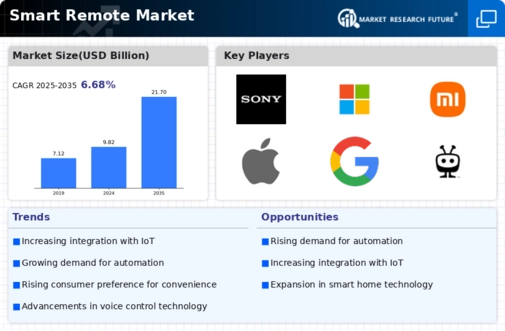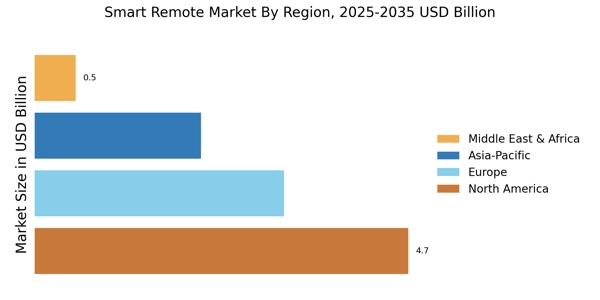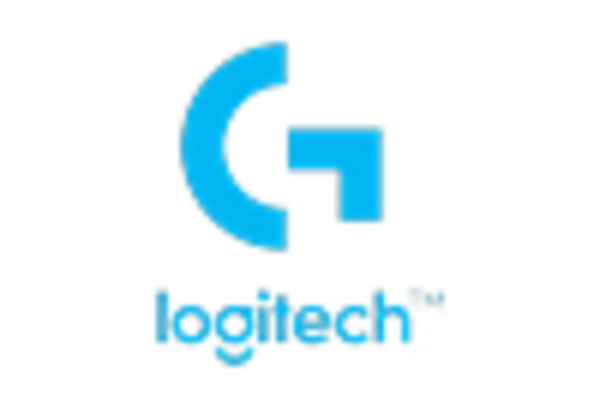Rising Demand for Smart Home Devices
The increasing adoption of smart home devices is a primary driver for the Smart Remote Market. As consumers seek to enhance their home automation experience, the demand for smart remotes that can control multiple devices seamlessly is on the rise. According to recent data, the smart home market is projected to reach a valuation of over 150 billion dollars by 2025, indicating a robust growth trajectory. This trend suggests that smart remotes, which serve as central control units for various smart devices, will likely see heightened demand. The integration of smart remotes with home security systems, lighting, and entertainment devices further enhances their appeal, making them indispensable in modern households. Consequently, the Smart Remote Market is poised for significant expansion as more consumers invest in smart home technologies.
Growing Popularity of Streaming Services
The surge in streaming services is significantly influencing the Smart Remote Market. With the increasing number of consumers subscribing to platforms such as Netflix, Hulu, and Amazon Prime, the need for efficient control mechanisms has become paramount. Smart remotes that can easily navigate multiple streaming services and provide quick access to content are in high demand. Market data indicates that the streaming industry is expected to surpass 100 billion dollars in revenue by 2025, underscoring the importance of smart remotes in enhancing the viewing experience. As consumers prioritize convenience and ease of use, the Smart Remote Market is likely to see continued growth, driven by the integration of features that cater specifically to streaming service users.
Consumer Preference for Multi-Device Control
The preference for multi-device control is a significant driver in the Smart Remote Market. Consumers increasingly desire solutions that allow them to manage various devices from a single interface. This trend is particularly evident in households with multiple smart devices, where the complexity of managing each device individually can be cumbersome. Smart remotes that offer compatibility with a wide range of devices, including televisions, sound systems, and smart home appliances, are becoming essential. Market analysis suggests that remotes capable of controlling at least five devices are preferred by consumers, indicating a shift towards multifunctional control solutions. As this preference continues to grow, the Smart Remote Market is expected to expand, catering to the evolving needs of tech-savvy households.
Increased Focus on User Experience and Design
The emphasis on user experience and design is shaping the Smart Remote Market. Manufacturers are increasingly recognizing the importance of creating intuitive and aesthetically pleasing remotes that enhance user interaction. Features such as ergonomic designs, customizable buttons, and touchscreens are becoming standard as companies strive to improve usability. Market trends indicate that consumers are willing to pay a premium for remotes that offer superior design and functionality. This focus on user experience not only attracts new customers but also fosters brand loyalty among existing users. As the competition intensifies, companies in the Smart Remote Market are likely to invest more in design innovations to differentiate their products and meet consumer expectations.
Technological Advancements in Remote Control Systems
Technological innovations are propelling the Smart Remote Market forward. The development of advanced technologies such as artificial intelligence and machine learning is enabling smart remotes to offer enhanced functionalities. These remotes can learn user preferences, automate tasks, and provide personalized experiences. For instance, the incorporation of AI allows for predictive control, where the remote anticipates user needs based on past behavior. Furthermore, the integration of IoT capabilities facilitates seamless connectivity with various devices, enhancing user convenience. As technology continues to evolve, the Smart Remote Market is likely to benefit from these advancements, attracting tech-savvy consumers who seek sophisticated control solutions for their smart homes.


















Leave a Comment